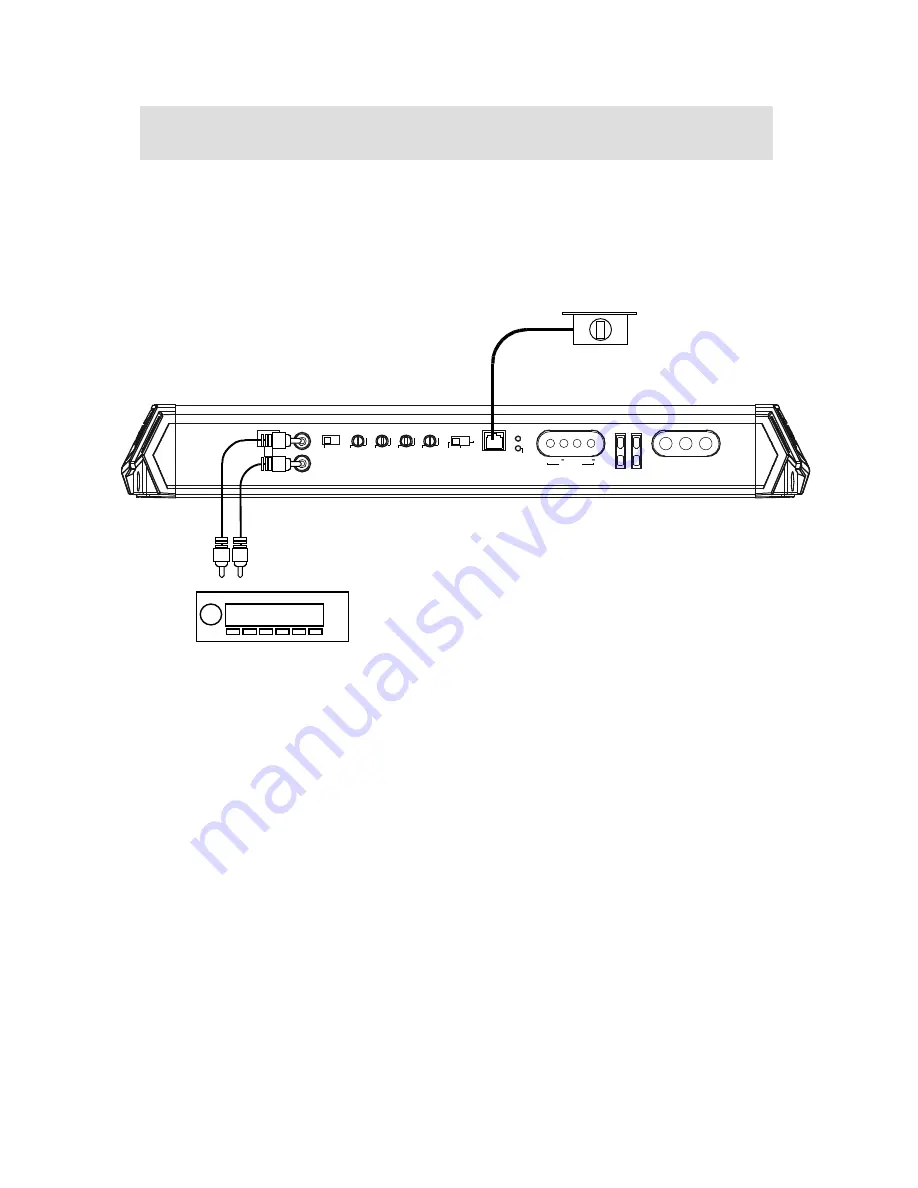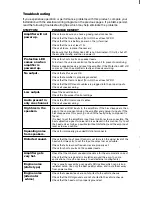
Troubleshooting
ONYX MOSFET Amplifier User’s Manual - page 18
ONYX MOSFET Amplifier User’s Manual - page 19
ONYX MOSFET Amplifier User’s Manual - page 5
ONYX MOSFET Amplifier User’s Manual - page 9
ONYX MOSFET Amplifier User’s Manual - page 15
ONYX MOSFET Amplifier User’s Manual - page 17
CONTENTS
ONYX MOSFET Amplifier User’s Manual - page 1
U S E R ’ S M A N U A L
ONYX MOSFET Amplifier User’s Manual - page 4
General precautions
ONYX MOSFET Amplifier User’s Manual - page 3
Features
About 2 Ohm operation
ONYX MOSFET Amplifier User’s Manual - page 6
ONYX MOSFET Amplifier User’s Manual - page 13
ONYX MOSFET Amplifier User’s Manual - page 14
ONYX MOSFET Amplifier User’s Manual - page 16
ONYX MOSFET Amplifier User’s Manual - page 12
ONYX MOSFET Amplifier User’s Manual - page 11
ONYX MOSFET Amplifier User’s Manual - page 10
Specifications
Notes
If you experience operation or performance problems with this product, compare your
installation with the electrical wiring diagram on the previous pages. If problems persist,
read the following troubleshooting tips which may help eliminate the problems.
Protection LED
comes on when
amplifier is
powered up.
Check for short circuits on speaker leads.
Turn down the volume control on the head unit to prevent overdriving.
Remove speaker leads, and reset the amplifier. If the Protection LED still
comes on, then the amplifier is faulty and needs servicing.
High hiss in the
speakers.
Disconnect all RCA inputs to the amplifiers. If the hiss disappears, then
plug in the component driving the amplifier and unplug its inputs. If the
hiss disappears at this point, go on until the faulty/noisy component is
found.
It is best to set the amplifier's input level control as low as possible. The
best subjective signal-to-noise ratio is achieved in this manner. Try to set
the head unit as high as possible (without distortion) and the amp input
level as low as possible.
Squealing noise
from speakers.
Check for improperly grounded RCA interconnects.
Distorted sound.
Check that the Input Level Control is set to match the signal level of the
head unit. Always try to set the Input Level as low as possible.
Check that all crossover frequencies are properly set.
Check for short circuits on the speaker leads.
Amplifier gets
very hot.
Check that the minimum speaker impedance for the amp model is correct.
Check that there is good air circulation around the amp. In some
applications, it may be necessary to add external cooling fan(s).
Engine noise
(static type)
This is usually caused by poor quality RCA cables,which can pick up
radiated noise. Use only the best quality cables, and route them away
from power cables.
Engine noise
(alternator
whine)
Check that speaker leads are not shorted to the vehicle chassis.
Check that the RCA grounds are not shorted to the vehicle chassis.
Check that the head unit is properly grounded.
Tri-Mode
Before installing and using your
new
amplifier, please be-
come familiar with all the infor-
mation contained in this manual.
Please keep this manual in a safe
place for future reference.
• Do not open or attempt to repair
this unit yourself. Dangerous high
voltages are present which may result
in electric shock. Refer any repairs to
a qualified service technician.
• To avoid risk of electronic shock or
damage to the amplifier, do not permit
any of this equipment to become
damp or wet from water or drinks. If
this does occur, immediately unplug
the power wires and send the amplifier
to your local dealer or service center
as soon as possible.
• If there is smoke or any peculiar
odor present during use or if there is
damage to any of the component
enclosures, immediately unplug the
power wire and send the amplifier to
your local dealer or service center as
soon as possible .
7. Insert fuse(s) into the battery fuse
holder(s).
8. Recheck all connections before
powering up the amplifier.
9. Set all level controls to minimum
position, and set all crossover
controls/switches to the desired
frequency points.
10. Power up the head unit and the
amplifier. Then set the volume control
on the head unit to about 3/4 volume,
and adjust the amplifier’s input level
control(s) to just below the level of
distortion.
11. Further fine tuning of the various
controls may be necessary to obtain best
results.
Your ONYX amplifier has been
designed to operate efficiently at loads
down to 2 Ohms. This means that you
can install four 8 Ohm speakers per
channel,
when using parallel wiring.
Increasing the number of woofers per
channel at low frequencies (below
100Hz) produces an acoustic coupling
effect. This acoustic coupling effect
increases your power output by about
3dB per speaker, or the equivalent of
an additional 10W per speaker.
When operating at 2 Ohms, the
amplifiers will increase their output
power by approximately 50%.
The
current draw will also increase by
about the same amount, so be sure
you have enough current to run the
amplifiers into a 2 Ohm load.
If you lack adequate current, your
music reproduction will be distorted.
Low-level (RCA) input wiring is preferred for best audio performance. Always use
a high-quality RCA cable for best audio performance.
Tri-Mode
To Audio
Outputs of head
unit or signal
processor
High Level Input Wiring
Low Level Input Wiring
NOTE: Do not connect BOTH the high level and low level inputs from your
receiver to your amplifier at the same time!
Low Level Input Wiring
2-Channel Amplifiers
NX3000.2
NX2000.2
NX1600.2
To Audio Outputs
of head unit or
signal processor
2
Introduction
2
What is included?
3
Features
3
About 2 Ohm operation
4
General precautions
4
Installation precautions
4
Mounting the amplifier
5
Connecting the amplifier
6
Low level input wiring
9
High level input wiring
11
MonoBlock Power and
Speaker wiring
12
2CH Power and Speaker wiring
2CH Mode
13
2CH Power and Speaker wiring
Bridged Mode
14
2CH Power and Speaker wiring
TriMode
15
4CH Power and Speaker wiring
4CH Mode
16
4CH Power and Speaker wiring
Bridged Mode
17
4CH Power and Speaker wiring
TriMode
18
Troubleshooting
19
Specifications
page
All specifications subject to change without notice.
RMS POWER
into 4 Ohms
MAX POWER
into 2 Ohms
BRIDGED POWER
into 4 Ohms
Min. speaker
impedance
THD
Frequency response
Signal-to-noise ratio
Channel separation
Damping factor
Crossover range
low pass
high pass
Bass boost
Fuse rating
Dimensions:
(10" x 2
-3/16
" x ...)
MODEL
4-Channel MOSFET Amplifiers
RMS POWER
into 4 Ohms
MAX POWER
into 2 Ohms
BRIDGED POWER
into 4 Ohms
Min. speaker
impedance
THD
Frequency response
Signal-to-noise ratio
Channel separation
Damping factor
Crossover range
low pass
high pass
Bass boost
Fuse rating
Dimensions:
(10" x 2
-3/16
" x ...)
MODEL
2-Channel MOSFET Amplifiers
1500W x 1
2800W X 1
n/a
2 Ohm Stereo
4 Ohm Mono Bridged
0.01%
15-250Hz
100dB
90dB
125+
35Hz-160Hz
n/a
Variable 0 - +18dB
25A x 2
15-1/8"
SYMPTOM
POSSIBLE REMEDY
+1 2V
GND
RE M
POWER CONNECTIONS
SUBWOOFER
LEVEL
CONT ROL
INPUTS
L
FUSES
POWER
PROTECTION
BASS
BOOST
0
+18
LOW PASS
FREQ
45Hz
90Hz
R
L +
HIGH LEVEL
INPUTS
L –
R+
R –
GND
MIN
MAX
INPUT
LEVEL
CROSSOVER
MODE
LOW PASS
HIGH
PASS
FULL RANGE
HIGH P ASS
FREQ
50Hz
500Hz
INPUT
SENSITIVITY
100mV-2V
2V-8V
SPEAKER CONNECTI ONS
L
+
R
+
B R I D GE D
Connect the Positive (+) terminal of the
subwoofer to the L (+) amplifier terminal.
Connect the Negative (-) terminal of the
subwoofer to the R (-) amplifier terminal.
Two
Channel
Mode
Bridged
Mode
Four Channel Mode
Bridged Mode
Connect the Postive (+) terminal of the RIGHT
subwoofer to the CH3(+) amplifier terminal.
Connect the Negative (-) terminal of the RIGHT
subwoofer to the CH4(-) amplifier terminal.
Connect the Postive (+) terminal of the LEFT
subwoofer to the CH1(+) amplifier terminal.
Connect the Negative (-) terminal of the LEFT
subwoofer to the CH2(-) amplifier terminal.
Chassis
ground
point
To FRONT
Audio Outputs
of head unit or
signal processor
To REAR
Audio Outputs
of head unit or
signal processor
To Speaker Terminals
of head unit
To Speaker Terminals
of head unit
Remote
Subwoofer Level Control





































